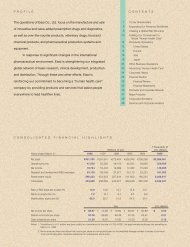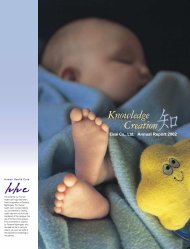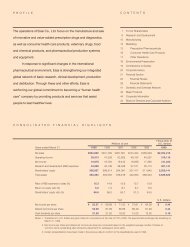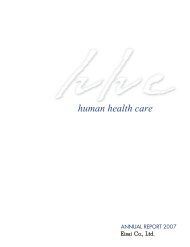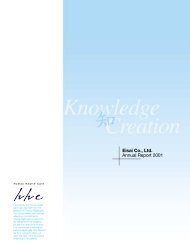Eisai Co., Ltd. Annual Report 2001 - Eisai GmbH
Eisai Co., Ltd. Annual Report 2001 - Eisai GmbH
Eisai Co., Ltd. Annual Report 2001 - Eisai GmbH
Create successful ePaper yourself
Turn your PDF publications into a flip-book with our unique Google optimized e-Paper software.
30<br />
(e) Property, plant and equipment<br />
Property, plant and equipment are stated at cost. Depreciation of property, plant and equipment of the <strong>Co</strong>mpany and its consolidated<br />
domestic subsidiaries is computed substantially by the declining-balance method at rates based on the estimated useful lives of the<br />
assets, while the straight-line method is principally applied to the property, plant and equipment of consolidated foreign subsidiaries.<br />
The range of useful lives of the <strong>Co</strong>mpany and its consolidated domestic subsidiaries is principally from 15 to 65 years for buildings and<br />
from 6 to 7 years for machinery and equipment.<br />
(f) Leases<br />
Leases related to the <strong>Co</strong>mpany and its consolidated domestic subsidiaries are accounted for as operating leases. Under Japanese<br />
accounting standards for leases, finance leases that deem to transfer ownership of the leased property to the lessee are to be capitalized,<br />
while other finance leases are permitted to be accounted for as operating lease transactions if certain “as if capitalized” information<br />
is disclosed in the notes to the lessee’s financial statements.<br />
(g) Income taxes<br />
The provision for income taxes is computed based on the pretax income included in the consolidated statements of income. The asset<br />
and liability approach is used to recognize deferred tax assets and liabilities for the expected future tax consequences of temporary<br />
differences between the carrying amounts and the tax bases of assets and liabilities. Deferred taxes are measured by applying currently<br />
enacted tax rates to the temporary differences.<br />
(h) Retirement and Pension Plans<br />
Under the employees’ retirement plans for the <strong>Co</strong>mpany and certain consolidated subsidiaries, prior to April 1, 2000, the annual<br />
provision for retirement benefits is calculated to state the liability for employees principally at the amount that would be required if all<br />
employees voluntarily terminated their employment at each balance sheet date, less amounts funded by a contributory pension plan<br />
disregarding a portion specified by government regulations<br />
Effective April 1, 2000, the <strong>Co</strong>mpany and its consolidated domestic subsidiaries adopted a new accounting standard for employees’<br />
retirement benefits and accounted for the liability for retirement benefits based on the projected benefit obligations and plan<br />
assets at the balance sheet date.<br />
The transitional obligation in the amount of ¥32,358 million ($260,952 thousand), determined as of the beginning of year in the<br />
<strong>Co</strong>mpany, was offset by the contribution of certain available-for-sale securities with a fair value of ¥15,128 million ($122,000 thousand)<br />
to the employee retirement benefit trusts for the <strong>Co</strong>mpany’s contributory pension plans in April 2000, and a related non-cash gain of<br />
¥1,383 million ($11,153 thousand) was recorded as “Gain on securities contributed to the retirement benefit trust”. The securities held<br />
in this trust are qualified as plan assets. The remaining unfunded balance of ¥17,230 million ($138,952 thousand) as well as ¥772<br />
million ($6,226 thousand) of the transitional obligaiton in the consolidated subsidiaries is being amortized over 5 years and charged to<br />
income and presented as operating expenses in the statements of income. As a result, net periodic retirement benefit costs as<br />
compared with the prior method, increased by ¥13,857 million ($111,750 thousand) and income before income taxes and minority<br />
interests decreased by ¥14,006 million ($112,952 thousand).<br />
Retirement benefits to directors and corporate auditors are provided at the amount which would be required if all directors and<br />
corporate auditors retired at the balance sheet date.<br />
(i) Appropriations of retained earnings<br />
Appropriations of retained earnings are reflected in the financial statements for the following year upon shareholders’ approval.<br />
(j) Research and development expenses<br />
Research and development expenses are charged to income as incurred.<br />
(k) Deferred charges<br />
Stock issuance costs and start-up costs are charged to income as incurred.<br />
Prior to April 1, 2000, certain subsidiaries capitalized start-up costs as deferred charges. Effective April 1, 2000, however, all the<br />
start-up costs were charged to income to unify accounting policies of the Gourp. The effect of this change was to decrease income<br />
before income taxes and minority interests for the year ended March 31, <strong>2001</strong>, by ¥302 million ($2,435 thousand).<br />
(l) Foreign currency transactions<br />
Prior to April 1, 2000, short-term receivables and payables denominated in foreign currencies were translated into Japanese yen at the<br />
current exchange rates at each balance sheet date, while long-term receivables and payables denominated in foreign currencies were<br />
translated at historical rates.<br />
Effective April 1, 2000, the Group adopted a revised accounting standard for foreign currency transactions. In accordance with the<br />
revised standard, all short-term and long-term monetary receivables and payables denominated in foreign currencies are translated<br />
into Japanese yen at the exchange rates at the balance sheet date. The foreign exchange gains and losses from translation are<br />
recognized in the income statement to the extent that they are not hedged by forward exchange contracts.<br />
(m) Foreign currency financial statements<br />
The balance sheet accounts of the consolidated foreign subsidiaries are translated into Japanese yen at the current exchange rates as<br />
of the balance sheet date except for shareholders’ equity, which is translated at the historical rate.<br />
Prior to April 1, 2000, differences arising from such translation were shown as “Foreign currency translation adjustments” as either<br />
all asset or liability in the consolidated balance sheet.<br />
Effective April 1, 2000, such differences are shown as “Foreign currency translation adjustments” in a separate component of<br />
shareholders’ equity in accordance with the revised accounting standard for foreign currency transactions.<br />
Revenue and expense accounts of the consolidated foreign subsidiaries are translated into yen at the average exchange rates.<br />
<strong>Eisai</strong> <strong>Annual</strong> <strong>Report</strong> <strong>2001</strong>



